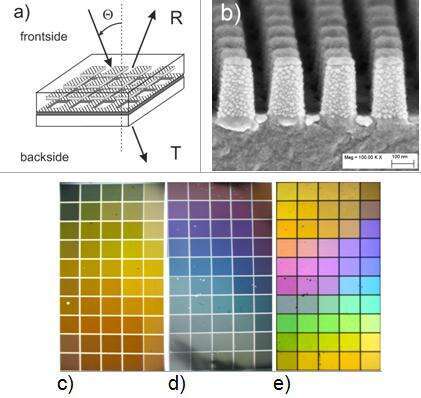
Color Filtering by Aluminum Nanodisc/Nanohole Arrays Embedded in Plastic Foils
Subwavelength gratings may exhibit distinct colours in the visible wavelength range. Several concepts have been proposed to use them as colour filters rather than conventional dye filters. Recently, coloured images have been generated by aluminum subwavelength gratings with laterally modulated grating profile [1]. Kumar et al. demonstrated color filtering in reflection by silver coated nanopillar gratings [2]. In a recent paper [3], an arrangement of a nanodisc and a nanohole grating was presented for color filtering of transmitted as well as reflected light. Moreover, these gratings exhibit a different hue on their front- and backside.
In the present paper, the color properties of this kind of gratings are studied for different periods and filling factors. Fig. 1a illustrates the geometry the grating comprised by a nanodisc/nanohole array having a quadratic shape. The metallic structure is completely surrounded by a dielectric. The gratings may be manufactured by a replication process which is well suited for cheap mass production. Starting from an e-beam written mould master, nanopillar gratings are replicated in UV resin on plastic foils by a simple nanoimprint process [3]. After directional evaporation of the nanopillar array with 40 nm aluminum, the grating of Fig. 1b is obtained. Finally, this structure was filled with UV resin to form a thin dielectric superstrate.
The coloring of frontside and backside reflectance as well as transmittance is demonstrated in Figs. 1c – 1e. This sample contains 5 x 10 different gratings. The grating period varies from 240 nm to 420 nm (bottom) along the vertical direction. The filling factor of the profile increases from 0.45 to 0.7 (right-hand side).
This study demonstrates that a large variety of colorings may be obtained by tuning the grating period and the filling factor. The relation between these grating parameters and plasmonic resonances in the visible wavelength range is discussed. This kind of nanostructured color filters will have ever more practical applications such as for security features.

References:
[1] H. Lochbihler, Opt. Express 17, 12189 (2009).
[2] K. Kumar et al., Nature Nanotechnology 7, 557 (2012).
[3] H. Lochbihler and Y. Ye, Opt. Lett. 38, 1028 (2013)
hans.lochbihler@gmail.com
Powered by Eventact EMS